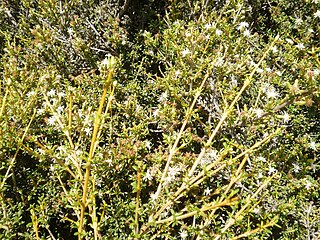
Olearia, most commonly known as daisy-bush, is a genus of flowering plants belonging to the family Asteraceae, the largest of the flowering plant families in the world. Olearia are found in Australia, New Guinea and New Zealand. The genus includes herbaceous plants, shrubs and small trees. The latter are unusual among the Asteraceae and are called tree daisies in New Zealand. All bear the familiar daisy-like composite flowerheads in white, pink, mauve or purple.
The flora of the Chatham Islands consists of around 388 terrestrial plant species, of which 47 are endemic. The Chatham Islands make up the Chatham floristic province of the Neozeylandic Region of the Antarctic Kingdom.

Olearia argophylla is a species of flowering plant in the family Asteraceae. Its common names are musk daisybush, musktree, muskwood and silvershrub. It is found in Australia, specifically in New South Wales, Tasmania and Victoria. It grows as a tall shrub or tree characteristic of wet sclerophyll forest. Its leaves are large and broad, coarsely toothed, green on top and silver-white underneath. The grain of the wood is mainly straight, but burls near the base of the tree are prized for their brown swirls that often suggest the appearance of small faces or animals peering out of the wood, making them highly sought after by woodworkers.

Olearia lyallii is a New Zealand plant from the genus Olearia. It is commonly known as the subantarctic tree daisy. The species is endemic to the Snares Islands and southern New Zealand, and has also established itself as an introduced species on the Auckland Islands, where the type specimen was described from. O. lyallii forms trees up to 10 m tall with trunks 50 cm in diameter.

Olearia hectorii is a species of flowering plant in the daisy family Asteraceae. Its common names include deciduous tree daisy and Hector's tree daisy. It is endemic to New Zealand.

Olearia traversiorum, the Chatham Island akeake, or Chatham Island tree daisy, is a species of flowering plant in the family Asteraceae. It is endemic to the Chatham Islands of New Zealand. It is also known by the synonym O. traversii.

Olearia phlogopappa commonly known as the dusty daisy-bush or alpine daisy-bush is a species of flowering plant in the family Asteraceae that is commonly found in eastern New South Wales, Victoria and Tasmania. It is a small shrub with greyish-green foliage, daisy-like flowers in white, pink or mauve that can be seen from spring to late summer.

Olearia colensoi, commonly known as tupare or leatherwood, is a sub-alpine shrub that is endemic to New Zealand. Other names it is known by in Māori are kūmarahou and kūmararaunui.

Olearia macrodonta is a small sub-alpine evergreen tree endemic to New Zealand, from the plant family Asteraceae. It is closely related to the narrow-leaved Olearia ilicifolia, with which it shares several characteristics including largely undulating and serrated grey-green leaves. These common characteristics mean the two species are often confused with one another. It is found in lowland to sub-alpine forests from the East Cape of the North Island of New Zealand southwards throughout the South Island and Stewart Island, at 450–1,200 metres (1,480–3,940 ft) in altitude.
Brachyglottis stewartiae is a species of flowering plant, often referred to as a tree daisy, in the family Asteraceae. It is found only in New Zealand, especially on its subantarctic islands. With another tree daisy, Olearia lyallii, it is common in the forest of the Snares Islands, growing to about 6 m in height. It bears conspicuous clusters of yellow daisy-like flowers.

Olearia rani, or heketara as it is known in Maori is a common small forest tree of New Zealand. It grows in lowland forest throughout the North Island and in the northern half of the South Island.

Olearia arborescens, also known as common tree daisy is a common shrub or small tree of New Zealand. It grows in lowland to alpine scrubland in the North Island from East Cape southwards, and throughout the South and Stewart Islands.

Olearia paniculata, commonly called akiraho, is a species of shrub or tree in the family Asteraceae, found only in New Zealand. The tree can grow to 6 metres high, and has yellow-green, oval-shaped leaves, with white undersides and wavy margins.

Olearia odorata, the scented tree daisy, is a small divaricating shrub endemic to New Zealand, from the plant family Asteraceae. It has small light green leaves with a large amount of interlacing twigs and grows to around 2–4m in height. In spring O. odorata produces many small white flowers.

Olearia solandri, commonly known as coastal daisy-bush or coastal tree daisy, is a coastal shrub of New Zealand.

Pachystegia is a genus of shrubs in the daisy family, known as Marlborough rock daisies, with distinctive leathery leaves and daisy-like flowers. They are naturally found only in dry areas of the north-eastern South Island of New Zealand.
Olearia adenocarpa or small-leaved tree daisy is a small divaricating shrub endemic to New Zealand, from the plant family Asteraceae. The bush grows up to 1.5 metres in height and 1.2 m wide. It has a smaller and open growth habit in comparison to Olearia odorata. It is trailing deciduous to semi-deciduous.

Olearia avicenniifolia, known commonly as mountain akeake, is a flowering plant in the aster family. It is endemic to New Zealand where it is found on the southern coastlines of the South Island and on Stewart Island. It is classified as Not Threatened.















